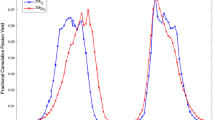Abstract
The major stochastic elements in the fission track dating method are (i) the number of spontaneous fission tracks (N s ) in a sample, and (ii) the number of induced tracks (N i ) observed when the sample is irradiated with neutrons. The foundations for the statistical uncertainty in these measures are of two kinds: (i) there exists a definite probability of uranium fission by means of natural decay and by neutron activation, and (ii) within a crystal the distribution of uranium is not uniform and perhaps follows something like a Poisson law. In any event, the natural logarithm of the ratio (N s /N i ) is proportional to age. A plausible statistical fission track dating model should, therefore, start by considering the joint distribution of N s and N i . In this paper a joint bivariate normal model is described which allows the rigorous definition of the probability distributions of Ns, N i , the ratio N s /N i , and age itself. A general computer program (FISSION) has been developed to perform all the necessary computations. By accounting for the correlation between N s and N i , the statistical model here ascribes smaller standard errors to N s /N i (and therefore age) than do previous methods. In addition, the error associated with neutron flux is a significant factor in the age relationships and has been incorporated into the model.
Similar content being viewed by others
References
Fieller, E. C., 1932, Distribution of the index in a normal bivariate population, Biometrika,24 p. 428–440.
Fleischer, R. L., Price, P. B., and Walker, R. M., 1965, Tracks of charged particles in solids, Science,149 p. 383–393.
Friedlander, G. and Kennedy, J. W., 1949, Introduction to radiochemistry, Wiley, New York, 412 p.
Gold, R, Armani, R. J., and Roberts, J. H., 1968, Absolute fission rate measurements with solid-state track recorders, Nuclear Sci. Eng.,34 p. 13–32.
Lindsey, D. A., Naeser, C. W., and Shawe, D. R., 1975, Age of volcanism, intrusion and mineralization in the Thomas Range, Key Mountain and Desert Mountain, Western Utah, Jour. Res. U.S. Geol. Sur.,3 no. 5, p. 597–604.
Tahirkheli, R. A. K. and Naeser, C. W., 1975, Zircon fission track age of post ranch ash bed near Besnon, Arizona, Ariz. Acad. Sci.,10 no. 2, p. 111–113.
Author information
Authors and Affiliations
Rights and permissions
About this article
Cite this article
McGee, V.E., Johnson, N.M. Statistical treatment of experimental errors in the fission track dating method. Mathematical Geology 11, 255–268 (1979). https://doi.org/10.1007/BF01034992
Received:
Revised:
Issue Date:
DOI: https://doi.org/10.1007/BF01034992




